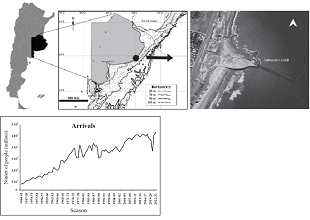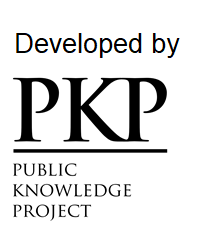Validation and automatic detection of the dispersive transport of the submarine outfall of Mar del Plata, Argentina
DOI:
https://doi.org/10.47193/mafis.3722024010506Keywords:
Sewage plume, coastal monitoring, radar images, Mar del Plata, ArgentinaAbstract
The submarine outfall of Mar del Plata city at Camet was projected considering the mean and maximum of forecasted sewage discharges, the inner-shelf depth, coliform concentration and its decay (T90) mainly induced by sunlight effect and costal salinity. In 2016 the outfall was operating with a length of 3,810 m and diffusers in the last 526 m. An economical method to monitor its performance in relation to the surroundings, is remote-sensing techniques, applying either visible or radar images. Tidal currents parallel to the coast are responsible for the transport of the sedimentary plume in the far field, after a primary dilution from a depth of 11 m. Visible images (1.5 to 6 m spatial resolution) are effective in monitoring the plume entrained in the upper portion of the water column. These analyses led to study the interaction between waves and coastal currents. Radar images (30 m resolution X and C bands) permit to survey the slick-alike plume that differs from the environment water by the surface roughness. Comparing both techniques visible images can distinguish the different colours of the plume; instead, the radar images are showing the surface roughness from the slick-alike plume. The main advantage of active sensors is that they can map the plume during a cloudy weather and even during night time.
Downloads
Metrics
References
Agenzia Spaziale Italiana. 2007. COSMO-SkyMed System Description & User Guide. Roma: ASI (Agenzia Spaziale Italiana).
Alfredini P, Arasaki E, De Melo Bernardino JC. 2017. Santos sea outfall wastewater dispersion process: physical modelling evaluation. J Coast Res. 33 (1): 173-190.
Axiak V, Pavlakis P, Sieber AJ, Tarchi D. 2000. Re-assessing the extent of impact of Malta’s (Central Mediterranean) major sewage outfall using ERS SAR. Mar Pollut Bull. 40 (9): 734-738.
Brekke C, Solberg AHS. 2005. Oil spill detection by satellite remote sensing. Remote Sens Environ. 95: 1-13.
Daneshgar ASL S, Dukhovskoy DS, Bourassa M, Macdonald IR. 2017. Hindcast modeling of oil slick persistence from natural seeps. Remote Sens Environ. 189: 96-107.
Del Frate F, Petrocchi A, Lichtenegger J, Calabresi G. 2000. Neural networks for oil spill detection using ERS-SAR data. IEEE Trans Geosci Remote Sens. 38 (5): 2282-2287.
Di Giacomo PM, Washburn L, Holt B, Jones BH. 2004. Coastal pollution hazards in southern California observed by SAR imagery: stormwater plumes, wastewater plumes, and natural hydrocarbon seeps. Mar Pollut Bull. 49: 1013-1024.
Elías R, Vallarino E, Scagliola ME, Isla F. 2004. Pre impact macrobenthos conditions at a sewage disposal site: inner shelf of Mar del Plata (38° S-57° W, SW Atlantic). J Coast Res. 20 (4): 1176-1182.
Elías R, Palacios JR, Rivero MS, Vallarino EA. 2005. Short-term responses to sewage discharge and storms of subtidal sand-bottom macrozoobenthic assemblages off Mar del Plata City, Argentina (SW Atlantic). J Sea Res. 53: 231-242.
Ferraro G, Baschek B, DE Montpellier G, Njoten O, Perkovic M, Vespe M. 2010.On the SAR derived alert in the detection of oil spills according to the analysis of the EGEMP. Mar Pollut Bull. 60: 91-102.
Gade M, Alpers W. 1999. Using ERS-2 SAR images for routine observation of marine pollution in European coastal waters. Sci Total Environ. 237/238: 441-448.
Hafeez S, Wong MS, Abbas S, Kwok CYT, Nichol J, Lee KH, Tang D, Pun L. 2018. Detection and monitoring of marine pollution using remote sensing technologies. In: Fouzia HB, editor. Monitoring of Marine Pollution. IntechOpen. DOI: https://doi.org/10.5772/intechopen.81657
Hang LM, Duong ND. 2009. Oil spill detection and classification by ALOS PALSAR at Vietnam East Sea. 7th FIG Regional Conference Spatial Data Serving People: Land Governance and the Environment. Building the Capacity. p. 1-12.
Holt B, Trinh R, Gierach MM. 2017. Stormwater runoff plumes in the Southern California Bight: a comparison study with SAR and MODIS imagery. Mar Pollut Bull. 118: 141-154.
Isla FI. 2010. Natural and artificial reefs at Mar del Plata, Argentina. J Integr Coast Zone Manage.10 (1): 81-93. DOI: https://doi.org/10.5894/rgci175
Isla FI. 2014. Variaciones espaciales y temporales de la deriva litoral, SE de la Provincia de Buenos Aires, Argentina. Rev Geogr Sur. 5 (8): 24-41.
Isla FI, Aliotta S. 1999. Storm dispersal of volcanogenic sands from Buenos Aires: where heavy-metal concentrations are heavy-mineral segregations. Mar Georesources Geotechnol. 17 (4): 357-370.
Isla FI, Casanelli A. 2000. Simulación del transporte dispersivo con decaimiento: futuro emisario submarino de Mar del Plata. Revista de la Asociación Argentina de Sedimentología. 6 (1-2): 61-73.
Isla FI, Cortizolc, Merlotto A, Bertola G, Pontrelli Albisetti M, Finocchietti C. 2018. Erosion in Buenos Aires province: coastal-management policy revisited. Ocean Coast Manage. 156: 107-116.
Isla FI, Perez C. 1998. Efectos de la capa urbano-canópea en los registros meteorológicos de Camet, Mar del Plata. 5º Jornadas Geológicas y Geofísicas Bonaerenses, CIC, Mar del Plata. 2. 59-60.
Isla FI, Perez Guzzi J, Zamora A, Folabella A. 1998. Aportes de coliformes a la costa de Mar del Plata por vías naturales e inducidas. Revista Thalassas. 14: 63-70.
Jaubet ML, Garrafo GV, Sánchez MA, Elías R. 2013. Reef-forming polychaetes outcompetes ecosystem engineering mussels. Mar Pollut Bull. 71: 216-221.
Ji H, Pan S, Han X. 2012. Effect of wastewater discharge on Jiangsu coastal environment, China. J Coast Res. 65 (1): 54-59.
Keramitsoglou I. 2005. Automatic identification of oil spills on satellite images. Environ Modell Software. 21: 640-652.
Klemas V. 2013. Airborne remote sensing of coastal features and processes: an overview. J Coast Res. 29 (2): 239-255.
Leifer I, Lehr WJ, Simecek-Beatty D, Bradley E, Clark R, Dennison P, Hu Y, Matheson S, Jones CE, Holt B, et al. 2012. State of the art satellite and airborne marine oil spill remote sensing: application to the BP Deepwater Horizon oil spill. Remote Sens Environ. 124: 185-209.
Manning SS, Dixon JP, Birch GF, Besley CH. 2019. Deepwater ocean outfalls: a sustainable solution for sewage discharge formega-coastal cities (Sydney, Australia): influences on beach water quality. Mar Pollut Bull. 145: 691-706
Marghany M. 2014. Oil spill pollution automatic detection from MultiSAR satellite data using genetic algorithm. In: Marghany M, editor. Advanced Geoscience Remote Sensing. IntechOpen. Chapter 3. p. 51-71. DOI: https://doi.org/10.5772/58572
Marghany M, Hashim M. 2012. Automatic detection algorithms for oil spill from Multisar data. Kuala Lumpur: Progress In Electromagnetics Research Symposium Proceeding. p. 1796-1800.
Mehmet S, Bulent S.2004. Survey over image thresholding techniques and quantitative performance evaluation. J Electron Imaging. 13: 146-165.
Moffa PE. 1996. The control and treatment of industrial and municipal stormwater. Van Nostrand Reinhold. 310 p.
Morea JP. 2011. Evaluación de impactos derivados de la construcción de una escollera en la intersección de las avenidas Constitución y Félix U. Camet. Mar del Plata, Argentina. Revista de Estudios Marítimos y Sociales. 4 (4): 175-184.
Muellenhoff WP, Soldate AM jr, Baumgartner DJ, Schuldt MD, Davis LR, Frick WE. 1985. Initial mixing characteristics of municipal ocean outfall discharges. Vol 1. Procedures and Applications. EPA/600/3-85/073a.
National Research Council. 1993. Managing wastewater in coastal urban areas. National Academy of Sciences. 477 p.
Nunziata F, Miglioccio M. 2015. Oil spill monitoring and damage assessment via PolSAR measurements. Aquat Procedia. 3: 95-102.
Otsu N. 1979. A threshold selection method from gray-level histogram. IEEE Trans Syst Man Cybern. 9 (1): 62-66.
Roberts PJW, Snyder WJ, Baumgartner DJ. 1989. Ocean outfalls I: submerged wastefield formation. J Hydraul Eng. 115 (1): 1-25.
Roth F, Lessa GC, Wild C, Kikuchi RKP, Naumann MS. 2016. Impacts of a high-discharge submarine sewage outfall on water quality in the coastal zone of Salvador (Bahia, Brazil). Mar Pollut Bull. 106: 43-48.
Scagliola M, Comino AP, Roberts P, Botelho D. 2021. The history of the Mar del Plata outfall system: a tale worth telling. Hydrolink. 6 p.
Serra J. 1982. Image analysis and mathematical morphology. Vol. 1. London: Academic Press.
Serra J. 1988. Image analysis and mathematical morphology. Vol. 2. London: Academic Press.
Topouzelis K. 2007. Detection and discrimination between oil spills and look-alike phenomena through neural networks. ISPRS J Photogramm Remote Sens. 62 (4): 264-270.
Vatnaskill. 1992. AQUASEA program. Reykjavik: Vatnaskill Consultant Engineers.

Published
How to Cite
Issue
Section
License
Copyright (c) 2024 Federico I. Isla, Luis C. Cortizo, Eduardo L. Blotta, Juan I. Pastore, Virginia L. Ballarin , Graciela V. Cuello

This work is licensed under a Creative Commons Attribution-NonCommercial-ShareAlike 4.0 International License.
Authors of articles published in Marine and Fishery Sciences retain copyright on their articles, except for any third-party images and other materials added by Marine and Fishery Sciences, which are subject to copyright of their respective owners. Authors are therefore free to disseminate and re-publish their articles, subject to any requirements of third-party copyright owners and subject to the original publication being fully cited. Visitors may also download and forward articles subject to the citation requirements. The ability to copy, download, forward or otherwise distribute any materials is always subject to any copyright notices displayed. Copyright notices must be displayed prominently and may not be obliterated, deleted or hidden, totally or partially.
This journal offers authors an Open Access policy. Users are allowed to read, download, copy, distribute, print, search, or link to the full texts of the articles, or use them for any other legal purpose within the Creative Commons 4.0 license (BY-NC-SA), without asking prior permission from the publisher or the author. This is in accordance with the BOAI definition of Open Access.

 https://orcid.org/0000-0002-0256-3064
https://orcid.org/0000-0002-0256-3064





























